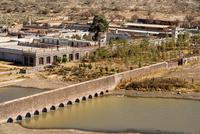You are in: North America -> Mexico -> Aqueduct of Padre Te... , and traditional search or Image Gallery will yield results of this site only
Aqueduct of Padre Tembleque Hydraulic System
| Site number: | 1463 |
|
| Type of site: | Cultural | |
| Date: | 16th century | |
| Date of Inscription: | 2015 | |
| Location: | North American, Mexico, Central Mexican Plateau | |
Up to 75 images are shown here. Click on each for more details or on Image Gallery for more images.
| Description: | This 16th century aqueduct is located between the states of Mexico and Hidalgo, on the Central Mexican Plateau. This heritage canal system encompasses a water catchment area, springs, canals, distribution tanks and arcaded aqueduct bridges. The site incorporates the highest single-level arcade ever built in an aqueduct. Initiated by the Franciscan friar, Padre Tembleque, and built with support from the local indigenous communities, this hydraulic system is an example of the exchange of influences between the European tradition of Roman hydraulics and traditional Mesoamerican construction techniques, including the use of adobe. --WHMNet's description is from WHC Site, where additional information is available. | |
| Originally constructed between 1553 and 1570, the aqueduct stretches 45 kilometres (28 mi) long, beginning at Tecajete volcano just east of Zempoala and terminating at Otumba. It passed mostly at ground level, but also went underground as well as over ravines and valleys. There are three arcades along the aqueduct: the first has 46 arches, the second has 13, and the third has 67 arches. The highest valley the aqueduct spans is Papalote ravine, which is crossed by the 67 arch arcade also known as the Main Arcade, with the tallest arch standing 38.75 metres (127.1 ft). --Wikipedia. Text is available under the Creative Commons Attribution-ShareAlike License. | ||
| Source: | http://whc.unesco.org/en/list/1463 | |
| Source2: | Wikipedia (http://wikipedia.com) | |
| Reference: | 1. UNESCO World Heritage Center (http://whc.unesco.org/en/list/1463). 2. Wikipedia. | |







